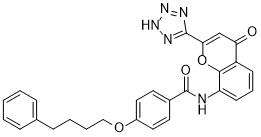This product is for research use only, not for human use. We do not sell to patients.

| Size | Price | Stock |
|---|---|---|
| 10g | $160 | Check With Us |
| 50g | $250 | Check With Us |
| 100g | $375 | Check With Us |
Cat #: V4685 CAS #: 103177-37-3 Purity ≥ 98%
Description: Pranlukast is a potent, selective and competitive antagonist of cysteinyl leukotriene receptor-1 (CysLT1) Pranlukast with Kis of 0.63±0.11, 0.99±0.19, and 5640±680 nM for inhibiting [3H]LTE4, [3H]LTD4, and [3H]LTC4 bindings to lung membranes, respectively.
Publications Citing InvivoChem Products
Product Promise

- Physicochemical and Storage Information
- Protocol
- Related Biological Data
- Stock Solution Preparation
- Quality Control Documentation
| Molecular Weight (MW) | 481.50 |
|---|---|
| Molecular Formula | C27H23N5O4 |
| CAS No. | 103177-37-3 |
| Storage | -20℃ for 3 years in powder formr |
| -80℃ for 2 years in solvent |
| Protocol | In Vitro | In the radioligand binding assay, Pranlukast (ONO-1078) inhibits [3H]LTE4, [3H]LTD4, and [3H]LTC4 bindings to lung membranes with Kis of 0.63±0.11, 0.99±0.19, and 5640±680 nM, respectively. The antagonism of Pranlukast against [3H]LTD4 binding is competitive. In functional experiments, Pranlukast shows competitive antagonism against the LTC4- and LTD4-induced contractions of guinea pig trachea and lung parenchymal strips with a pA2 range of 7.70 to 10.71. In the presence of an inhibitor of the bioconversion of LTC4 to LTD4, Pranlukast also antagonizes the LTC4-induced contraction of guinea pig trachea (pA2=7.78). Pranlukast significantly reverses the LTD4-induced prolonged contraction without effect on the KCl- and BaCl2-induced contractions of guinea pig trachea |
|---|
| Solvent volume to be added | Mass (the weight of a compound) | |||
|---|---|---|---|---|
| Mother liquor concentration | 1mg | 5mg | 10mg | 20mg |
| 1mM | 2.0768 mL | 10.3842 mL | 20.7684 mL | 41.5369 mL |
| 5mM | 0.4154 mL | 2.0768 mL | 4.1537 mL | 8.3074 mL |
| 10mM | 0.2077 mL | 1.0384 mL | 2.0768 mL | 4.1537 mL |
| 20mM | 0.1038 mL | 0.5192 mL | 1.0384 mL | 2.0768 mL |
This equation is commonly abbreviated as: C1 V1 = C2 V2
- (1) Please be sure that the solution is clear before the addition of next solvent. Dissolution methods like vortex, ultrasound or warming and heat may be used to aid dissolving.
- (2) Be sure to add the solvent(s) in order.




































